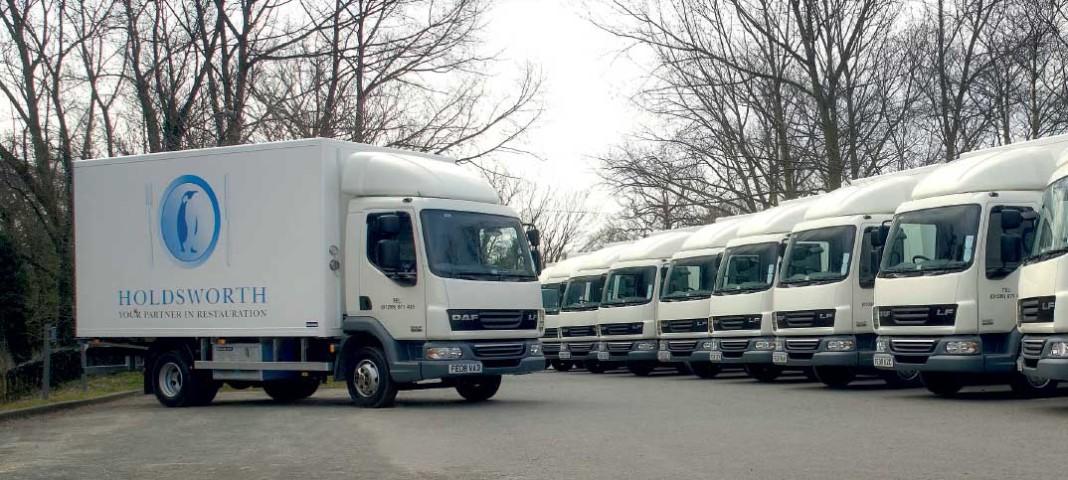Tan Parsons finds Holdsworth’s success is down to quality, service and people.
With a geographical reach stretching from the south coast up through London and west to Bristol, and from the bottom of the Lakes to the top of Newcastle, Holdsworth serves catering outlets across two-thirds of the country.
Fast facts
- Founded: 1969
- Number of live SKUs: 5,000
- Annual turnover: £74m
- Buying group: Today’s
- Number of depots: 8
- Top selling products: Chips, fresh meat, cheese, frozen fruit and veg
- Number of customers: 7,000
The wholesaler has a fleet of more than 100 vehicles that deliver ambient, chilled and frozen goods to customers ranging from pubs, restaurants and hotels to coffee shops, sandwich bars and schools. Quality of service is everything in the catering market and last year Holdsworth recorded a delivery accuracy of more than 99%.

“People move on in any industry and customers move around, but generally they come back to us because we give good service,” says procurement manager John Colton. “We’ve a good reputation and we care about our customers.”
Holdsworth is a family business and also has a management team with a fairly flat structure, which means that decisions can be made quickly.
“I make all the decisions on procurement, the sales manager makes all the decisions on sales, so decisions happen quickly,” he says. “One of our greatest assets is our reputation as a quick-thinking business – our ‘get things done’ approach brings customers to us.”
This attitude, combined with care and attention, is evident in the wholesaler’s approach to its customers, its salespeople effectively acting as business development managers.
Indeed, while technology has transformed the way wholesale works, Colton believes you need people and face-to-face contact to succeed.
“If you look at the nature of suppliers and manufacturers, resources have been reduced over the years. Nobody sells anything anymore – it all just gets listed and left to technology.
“With foodservice, menus can be complex. You need troops on the ground – people knocking on the doors, supporting the industry. So we now have more than 30 salespeople on the road who are looking to develop ideas and menus with cafés.”
Holdsworth works with all the big brand suppliers. Colton says good supplier relationships are based on a long-term approach to promotions and pricing.
“The Today’s Group is fundamental to our negotiations with big-brand suppliers. Our return on investment as a member is excellent.”
Having a mix of big brands, challenger brands and niche products is important in foodservice, he says. In crisps and snacks, for example, Holdsworth stocks Walkers, Tyrrells, Real Crisps and Pipers – a brand which is particularly strong in the Midlands and the North.
“Walkers is the brand leader – the typical pub would sell Walkers,” he says. “But a typical coffee shop wouldn’t want to offer Walkers crisps because they are in every convenience store and high street store. They would want something different. Regionality comes into play.
“In soft drinks, I need Coca-Cola and Pepsi, but consumers would want a different experience in a coffee shop in terms of Belvoir Presse, Fentimans or Feel Good drinks. You’d want a glass bottle as opposed to plastic.”
From a procurement perspective, Colton says it’s important to keep an eye on exchange rates, with so many products coming from abroad. He says that falling food prices caused by deflation are having an impact and the dairy industry is in crisis.
“Italian meats, continental cheeses – we’ve seen a 15‑20% reduction in price.” He tends to look for contracts of six to 12 months with key commodity suppliers.
Once you have a good balance of products, it’s also important to let people know about it. Holdsworth’s marketing department supports both customers and the company’s own staff with four annual product brochures and price lists covering frozen foods, chilled products and butchery, and ambient goods.
There is also a Christmas price list, along with a monthly ‘Delicious Deals’ offers list, which is supported by regular product focus weeks for suppliers to visit the depots to cook and prepare their products and educate both Holdsworth team members and customers.
Since its beginnings in 1969, Holdsworth has developed through a mix of organic sales growth and acquisitions.
Last year saw the development of a new cold store warehouse and distribution depot adjacent to its existing site at Markham Vale, Chesterfield. This depot became fully operational at the end of last year, after a capital investment of more than £2m.
Over the past five years, as well as opening a new depot in Essex, the wholesaler has acquired four new businesses in Derbyshire, Yorkshire, Staffordshire and Lincolnshire. These acquisitions include a specialist catering butcher, which has greatly expanded the range and diversity of products Holdsworth can offer. It’s been instrumental in the company’s strategy to target the hotel and restaurant trade.
sThe wholesaler now has about 20 skilled butchers who can meet customers’ requirements, such as preparing steaks to certain specifications or assorting various mixed grills.
It’s a world away from where the business has been historically, says Colton, and it also creates a point of difference.
“We wholesalers are all selling mayonnaise, for example, but not everyone is able to put together a mixed grill for the customer.”
He says that as the economy has strengthened, people have been choosing to go for quality dining experiences.
“The days of the two-for-£7 or two-for-£8 meals will start to disappear even more as confidence picks up. And it’s good news for wholesalers.”
One pub group customer trialled Holdsworth’s fresh meat, despite it being more expensive than their previous supplier’s offering, and the company’s sales have since gone up substantially as a result, says Colton.
“It’s not cheap – it’s down to quality. And it’s consumer-led. They are prepared to go out more and they are spending more when they go out.”









I too was disappointed in Zuven’s decision. I loved the book but the ending was so open that I didn’t feel happy when I finished it. The story and the characters were great but the ending was not as fulfilling as it could have been, it didn’t all fall into place and that was a great disappointment.
Various Internet sources report that between 5 and 13 percent of all donations to the Red Cross go to administrative costs (the legal limit for administrative costs in order to continue operating as a charity is 20 percent). Nevertheless, there is still room at the top for a reasonable executive inAcem.ccoording to United Press International, Gail McGovern took over as CEO of the American Red Cross in 2008 at an annual salary of $500,000 plus a signing bonus of $65,000.